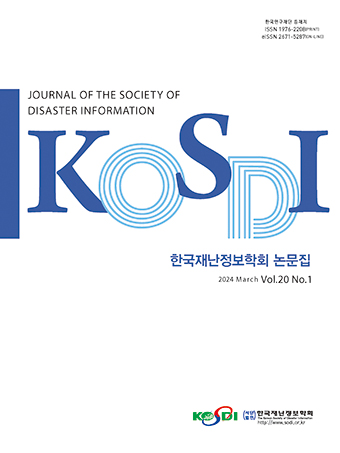Original Article
Abstract
References
Information
Purpose: In the event of a fire in a high-rise building, if the smoke control area is not effectively protected, smoke or flames enter the stairwell, making it difficult to evacuate. When inflowing air is discharged from a closed corridor, a negative pressure is formed in the corridor, the pressure in the smoke control area becomes excessively high, and the force required to open the door during evacuation is exceeded. Also, if the air introduced into the hallway is not exhausted, the smoke may flow back into the smoke control area. This paper tried to identify the problems caused by the inflowing air and to find out how to improve the performance. Method: Using the CONTAM program, simulations were performed with the basic conditions and the modified conditions. Result: If the inflowing air was discharged from the sealed corridor, overpressure occurred in the Smoke Control Area and exceeded the opening force, and the prevent smoke backflow was insufficient in the layer where the inflowing air was not discharged. Conclusion: “Differential pressure exhaust damper” application, simultaneous opening of two exhaust dampers, and automatic window installation between corridors and outdoors improved the exhaust performance of inflowing air.
연구목적: 고층 건물 화재시 제연구역이 효과적으로 보호되지 않으면 수직피난경로에 연기나 화염이 유입되어 대피가 어려워진다. 국가화재안전기준에서는 제연구역에 차압 및 방연풍속을 공급하여 능동적으로 연기 유입을 억제하고, 제연구역으로부터 옥내로 유입되는 공기는 옥외로 배출되도록 하고 있다. 본 연구는 유입 공기의 배출로 인한 문제점을 확인하고 성능개선 방안에 대하여 알아보고자 하였다. 연구방법: CONTAM 프로그램을 사용하여 기본조건과 변경조건으로 시뮬레이션을 수행하였다. 연구 결과: 밀폐된 복도에서 유입 공기가 배출되면 제연구역에서 과압이 발생하여 개방력을 초과하였고 유입공기가 배출되지 않는 층 에서는 방연풍속이 미달하였다. 결론: “차압 배출댐퍼” 적용, 배출댐퍼 2개층 동시 개방, 복도와 옥외 사이 자동식 창문 설치로 유입공기의 배출 성능이 개선되었다.
- Hwang, J.S. (2021). "A study on the performance improvement of smoke control with smart dampers." The Korean Society of Disaster Information Proceedings of the Regular Academic Conference, Seoul, pp. 293-294.
- Jang, G.H. (2018). A Study on Leakage Amount and Differential Pressure of Inflowing Air Exhaust Damper of Smoke Control System. Ph. D. Kyonggi University, Suwon, pp. 56-57.
- Kim, B.G., Choi, K.O., Choi, D.M. (2021). "Performance improvement of smoke-control system using CONTAMW." Fire Science and Engineering, Vol. 35, No. 3, pp. 53-58. 10.7731/KIFSE.303bfbc8
- Kim, I.Y., Yoo. C.G., Kwon. C.H. (2017). Smoke Control Simulation Practice, Book publishing City and People, Anyang, pp.146-282.
- Kim, I.Y., Kim, K.J., Hong, J.H., Kwon, C.H., Yo, C.K. (2019). "A study on design improvement for smoke-control system using the pressurization of the elevator shaft." Fire Science and Engineering, Vol. 33, No. 3, pp. 74-83. 10.7731/KIFSE.2019.33.3.074
- Lee, J.O., Choi, C.S. (2012). "Study on the analysis of differential pressure of the access door for a smoke control zone and the effectiveness of the measurement criteria of its opening force." Fire Science and Engineering, Vol. 26, No. 4, pp. 24-30. 10.7731/KIFSE.2012.26.4.024
- Lee, K.S., Yoon, M.O., Lee, J. (2021). "A study on effectiveness of prevent smoke backflow in apartment." Journal of the Society of Disaster Information, Vol. 17, No. 1, pp. 1-9.
- National Institute of Standards and Technology, https://www.nist.gov/
- NFSC 501A (2021). Fire Safety Standards for Stairwells and Auxiliary Rooms of Special Evacuation Stairs, National Fire Agency public notice No. 2017-1.
- NFSC 501A Explanation 5 Books (2020). Fire Safety Standards for Ventilation Equipment in Stair Rooms and Auxiliary Rooms of Special Evacuation Stairs Explanation, National Fire Agency, pp. 258-262.
- Publisher :The Korean Society of Disaster Information
- Publisher(Ko) :한국재난정보학회
- Journal Title :Journal of the Society of Disaster Information
- Journal Title(Ko) :한국재난정보학회논문집
- Volume : 18
- No :2
- Pages :241-251
- DOI :https://doi.org/10.15683/kosdi.2022.6.30.241




 Journal of the Society of Disaster Information
Journal of the Society of Disaster Information







